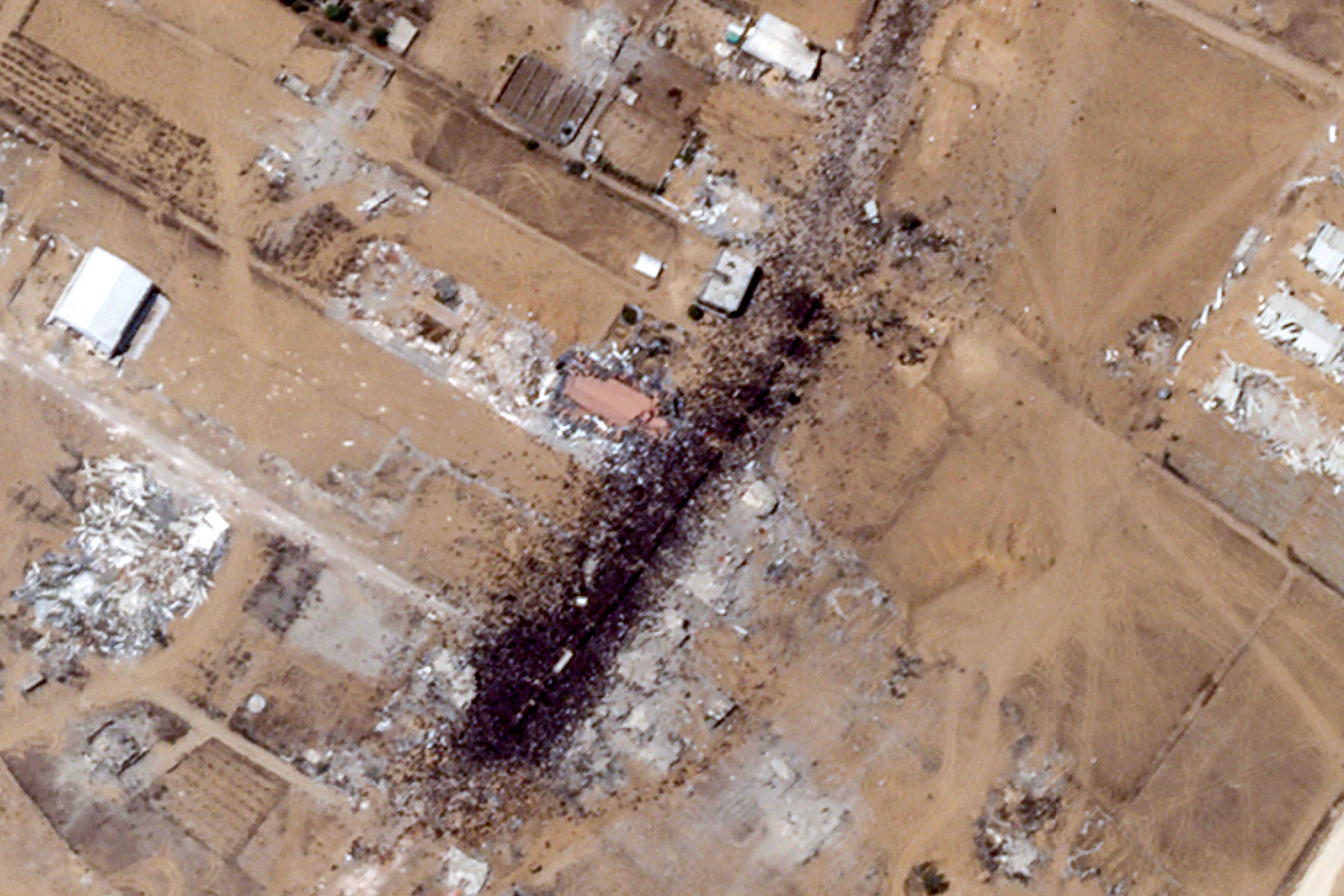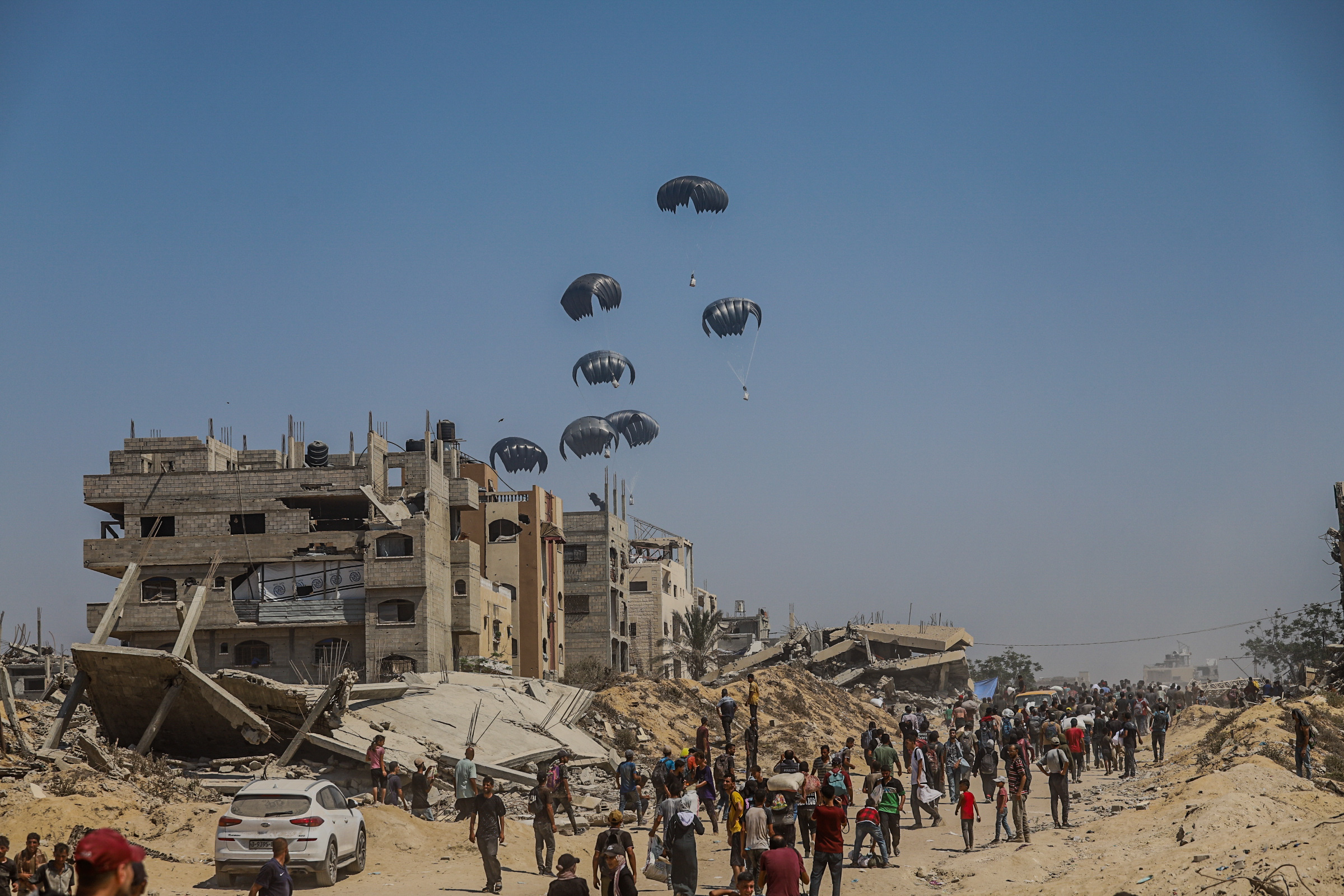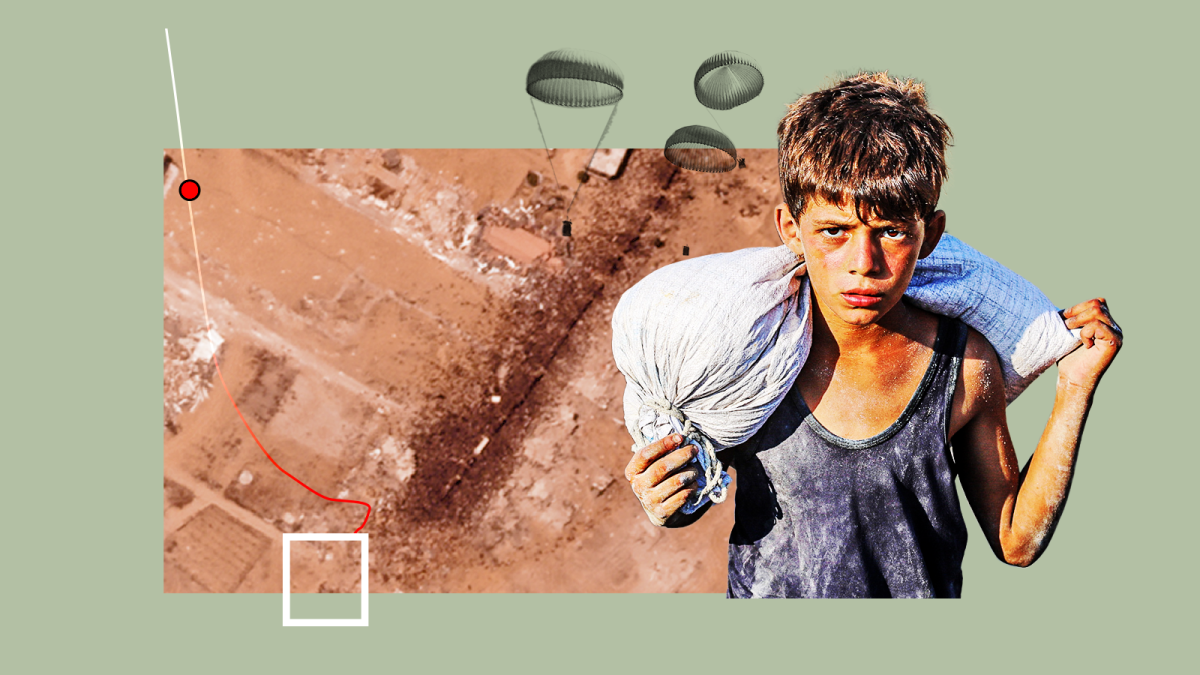Hunger is sweeping Gaza as aid distribution fails to meet the needs of the population. The World Food Programme says that a third of the population has not eaten for days, in what it describes as “man-made mass starvation”.
On Friday, President Trump’s Middle East envoy, Steve Witkoff, visited an aid distribution site in Gaza operated by the US-run Gaza Humanitarian Fund (GHF). Hinting at plans for change, he said the purpose was to give the president “a clear understanding of the humanitarian situation and help craft a plan to deliver food and medical aid to the people of Gaza”.
Israel denies there is a famine in Gaza. Last week President Trump said that “based on television” he was unconvinced by the denials of Binyamin Netanyahu’s government, “because those children look very hungry”.

Salih Juha, pictured on July 28 aged five, is severely malnourished
MOHAMMED YM AL-YAQOUBI/ANADOLU/GETTY IMAGES
Trump promised that the United States would do more to address the food crisis. “We can save a lot of people,” he said. “That’s real starvation; I see it and you can’t fake that. So we’re going to be even more involved.”
More people have died as a direct result of malnutrition in Gaza in the past 11 days than in the previous 21 months of conflict, according to data from the Hamas-run ministry of health.
The Israel Defence Forces (IDF) paused fighting last Sunday to ease obstacles to aid access and permitted air drops for the first time since November. But health organisations warn that months of sustained access to food is needed to treat malnutrition, and that for many it may already be too late.
When aid does enter Gaza and Israel grants permission to transport it, it is being looted. Israel has consistently blamed Hamas for stealing aid. Hamas has accused Israel of “consciously seeking to spread chaos and engineer famine”. The UN says looting is due to desperation and that the only way to restore order is to flood Gaza with supplies.

A satellite image shows hungry Palestinians crowd around an aid truck in Khan Yunis and, below, at another location in southern Gaza
PLANET LABS

IBRAHIM AL-SALOT/STORYFUL
Scarcity of food is self-reinforcing: limited aid makes hunger rampant and theft highly profitable, meaning less food reaches those who need it. Obstruction of access, widespread need, lack of law enforcement with the groups vying for control in a power vacuum are all making distribution harder and more dangerous.
Seeking aid is as deadly as malnutrition for Gazans, UN figures show. More than 1,100 people have been killed in the process, the vast majority of them by the IDF, according to witnesses and medical staff. Seven thousand aid seekers have been injured.
How we got here
The humanitarian crisis began to intensify in March when Israel blocked all aid from entering Gaza, an attempt to press Hamas into making concessions. The blockade lasted two and a half months, hunger rose and the politics of aid distribution became increasingly fraught.
Since then Israel has sought to blame the UN for failing to distribute aid that the IDF has allowed in. The UN has said that Israel won’t let its teams do their job.
In May, Israel set up a mechanism led by a new US-run group called the Gaza Humanitarian Fund (GHF).
Aid was delivered to ‘safe distribution sites’ numbered SDS1-4:
Aid seekers queue to enter a GHF site
EYAD BABA/AFP/GETTY IMAGES
Previously aid was delivered by international NGOs to 400 distribution spots in Gaza.
The change in mechanism means the population must walk through a war zone to receive aid.
The IDF says “locations are determined in accordance with political echelon directives in order to enable the distribution of humanitarian aid to residents of the Gaza Strip and to prevent Hamas from taking control of the aid.”
They added that there was an “ongoing assessment of distribution centre locations” and changes are being made to their deployment to improve safety.
The GHF says it will offer aid anywhere Israel will allow it and wants more sites in the north, but at present aid zones are concentrated in southern Gaza.
Many Gazans, especially the elderly, sick and disabled, cannot walk to these sites, meaning that those who risk their lives to seek aid are mostly young men.
The UN said last week that of the 1,054 people killed seeking aid, 766 were near GHF sites and the rest were trying to reach UN convoys.
Data from ACLED, a non-profit monitoring service, provides an updated figure of 1,137 deaths by July 25. They found the IDF was reported as responsible for the majority of fatalities, but that 63 of those killed near aid sites were targeted by armed Palestinians.
GHF acknowledged that 19 people were killed in a stampede at their distribution site on July 16, which they accuse Hamas of fomenting. Palestinians working for GHF have been killed in ambushes and foreign staff have been injured.
Surgeons volunteering in Gaza told The Sunday Times of a surge in admissions since May from those injured seeking aid. Many of the wounded are failing to recover because their bodies are already weakened by malnutrition, they said.
The only alternative for those who are not prepared to risk the journey is slow starvation and death.
The aid trap
“It is 2025, and people are dying because they need a bag of flour,” Mohammed Fadlalla, a surgeon from Doctors Without Borders, said in a phone call from Gaza last week.
His day’s work is dictated by waves of patients being admitted after being shot at by the IDF while seeking aid.
Fadlalla, who normally works in a hospital in Cincinnati, Ohio, said the patients described being “indiscriminately sprayed with bullets” by Israeli forces on their way to GHF sites.
“It’s a game of chicken with your life,” he said. “You are corralled in an area. If you come too early, you’re a target. If you come too late, you’re a target. The food is dropped and it’s a mad dash to grab what you can.”
“After ten or fifteen minutes, they open fire and everybody runs for their lives. People are being indiscriminately sprayed with bullets, whoever they are. We even see children getting caught in this crossfire.”

Palestinians transport a man, wounded as he waited for humanitarian aid at a GHF aid distribution point, at the entrance of the Bureij refugee camp on July 30
EYAD BABA/AFP/GETTY IMAGES
Dr Goher Rahbour, an NHS gastrointestinal surgeon who volunteered with Medical Aid for Palestinians from late May to early July, recalls the first day he operated on Gazans who had been shot seeking aid.
It was June 1, and Nasser Hospital in Khan Yunis had 200 patients arrive after being injured seeking aid. A further 30 patients were dead on arrival.
His patients described being shot at by quadcopter drones and IDF soldiers from tanks. They said that GHF staff had shot dispersal bullets at crowds, but it was the IDF who had shot, killed and injured Gazans with M16 rifles.
Rahbour fished out M16 bullets from patients, wondering how so many had been shot in both the head and the shoulder. He later heard from patients that they had been lying down taking cover when the IDF shot bullets in all directions.

Aid seekers take cover from gunfire on June 9, near the Netzarim Corridor
EHAB NUOR/STORYFUL
“After surgery on his abdomen, one 20-year-old patient told me that he and his three friends had gone to get aid from the GHF site,” Rahbour said. “One of his friends died next to him, and the rest had to lie on the ground for an hour and a half before they could get up.”
Even if patients survive getting shot, many are failing to recover from their operations due to a lack of nutrition, he said. Fadlalla concurred, describing how wounds will repeatedly reopen after surgery.
“We’re seeing people needing to go back for repeat surgeries after their bowel reopens. We have a lot of complex wounds from all the bullet injuries that leave gaping holes in arms, legs, backs, bellies, and their bodies are just unable to produce what they need to heal these really complex wounds. We’re also seeing a lot of wound infections and [malnutrition means] our patients’ bodies are unable to fight off bacterial infections.”
Dr Sarmad Tamimy, an NHS plastic surgeon who returned from volunteering in Gaza with Medical Aid for Palestine last week, said that although it was a horrible thought, on his darkest days he believed the ones who had died at the GHF sites were luckier than the injured.
“Once they come in with these injuries, there is not enough medicine for them, there is not enough dressings for them. Even if you are managing to operate on them, they’ll end up going into wards without enough equipment to look after them, they’ll get horrible infections, they’ll keep on coming back to the theatre and they will then die a more miserable death,” he said. “And if they survive that incident, they will go again, because otherwise they will die of hunger.”
There is also a lack of blood to treat these severe injuries because it is donated by Gazans themselves, who are increasingly too unhealthy to donate.

Palestinians shot by the IDF at a food distribution point receive care at al-Awda hospital on June 24
EYAD BABA/AFP/GETTY IMAGES
Tamimy first went to Gaza last December, but on his return this year he was shocked to see his colleagues at Nasser Hospital. “It was difficult to see them. They are half the size that they used to be. They were all significantly malnourished, literally emaciated. One of my medical students, his thighs were the size of my wrists.”
The GHF insists that they only use dispersal bullets and stun grenades at crowds, and that they do not shoot directly at those seeking aid.
Stun grenades were thrown at a group of Gazans gathered at an aid distribution point on May 29, according to the local who took this video:

IBRAHIM AL-QATRAWI/STORYFUL
Their distribution system works by dropping boxes of aid in a fenced field. A green flag is raised to indicate that the site can be approached and the gates are opened.
The crowd will run towards the aid after hours of waiting and either leave with whole boxes or open them to take the items they want. Items are often bartered for others or sold so people can buy other goods.
When the aid is close to running out, a red flag will be raised and smoke grenades will be released to indicate that aid seekers should leave the site.
Recently, the GHF has tried collections exclusively for women and children. After the men’s drop has been completed, women and children enter the site and queue.
When aid seekers leave the site, they may come under IDF fire and must travel back to their tents through a war zone because they have been displaced from their homes. There have been reports of aid seekers being robbed en route by other desperate civilians or armed gangs. The IDF has also killed Gazans seeking aid in airstrikes near distribution sites.
“We unequivocally condemn any harm inflicted upon civilians seeking aid, regardless of where the fire is coming from,” the GHF spokesman, Chapin Fay, said.
“We have one mission and it’s to feed the people of Gaza. When Hamas does things that make that more difficult, or when the IDF or the government of Israel does things that make that more difficult, we call them out. We work to deconflict every day with the IDF to ensure the safety of our sites and the pathways in and out.”

EYAD BABA/AFP/GETTY IMAGES
In response to reports of aid seekers being killed by their forces, the IDF said: “thorough examinations were conducted,” and “instructions were issued to forces in the field following lessons learned.” The incidents are under review “by the competent authorities in the IDF”.
“IDF forces conduct systematic learning processes aimed at improving the operational response in the area and minimising possible friction between the population and the IDF forces as much as possible. As part of this effort, IDF forces have recently worked to reorganise the area through the installation of fences, signage placement, the opening of additional routes, and other measures.”
Civilians have also been killed seeking UN aid: on July 20, World Food Programme (WFP) trucks were stormed by crowds next to Zikim crossing and the IDF opened fire. The organisation said this was an example of how armed forces being near aid points risks civilian life.
Antoine Renard, the food programme’s Palestine director, said that in the January ceasefire prior to Israel’s aid blockade, looting was not a systematic problem. Now, hunger is so widespread that convoys are routinely raided by desperate civilians. The answer, he says, is to increase aid access.
UN data shows that between May 19 and July 24, 92 per cent of World Food Programme trucks were intercepted either by armed looters or by non-violent civilians desperate for food. The WFP is the largest UN-aid organisation supplying food to Gaza since Israel’s ban on UNRWA, which it accuses of colluding with Hamas.
Fay, the GHF spokesman, said it wanted to expand operations but the “primary obstacle is that the UN and other aid groups refuse to work with us”.
“We can help them get their thousands of trucks of aid — many of which are just sitting over the border in Gaza, rotting — out safely and securely without diversion or interference.”

Packages of aid await collection inside Gaza near the Kerem Shalom crossing with Israel
COGAT
Renard of the WFP said: “It’s not because we don’t know how to do our job that we have aid anchored at a platform in Gaza that has not yet reached the population. It’s that to move from the platform to the people we are facing a number of hurdles that need to be lifted by Israel.”
Renard described how trucks were being repeatedly held up for hours by the IDF. Without permission to continue, their trucks will come under Israeli fire.
Last week limited aid trucks crossed into Gaza via the Rafah crossing. This was the first time the crossing had been opened since it was seized by the IDF in spring last year.
Air drop danger
Last weekend Gaza received its first airdropped aid since November. Some 3,775 tonnes of food and relief supplies have been dropped by the UAE, Jordan and Israel. At the end of the week France, Canada, Spain and Germany followed suit.

EYAD BABA/AFP/GETTY IMAGES
However, Doctors Without Borders describes air drops as “dangerous and ineffective”. Last year at least five Gazans were killed in the process.
Videos documenting the aftermath of aid drops show men fighting over limited parcels. It was reported that some aid was airdropped into militarised areas under IDF evacuation order, increasing the risk to aid seekers.

Many Gazans have shared videos deriding the aidrops as humiliating. Proponents argue they are necessary given the scale of malnutrition, but that they should not replace on the ground transport of the aid which Gazans desperately need.
